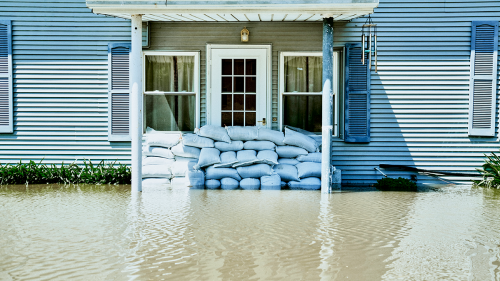Climate change is risky business
Imagine the impact on mortgages if climate change would cause mass flooding. Or what would happen to the value of houses if governments would enforce stricter energy efficiency measures faster than expected. And then imagine the impact situations like these would have on consumers and companies, and ultimately on banks like ING. This is how climate risk also becomes financial risk.

Physical climate risk can be ‘event-driven’, such as floods caused by extreme weather.
That’s why assessing and managing climate risk is important. It’s an area that continues to evolve and will mature as more and more data on the impact of climate becomes available and methodologies are further developed. Now ING has released our first climate risk report (PDF, 10.3 MB). Here are some takeaways.
Climate action and climate risk are two sides of the same coin
With the Terra approach, ING commits to align our portfolio with the climate goals of the Paris Agreement. This addresses the question: what is the impact of our business on climate change?
In our approach towards climate risk, we address the question: what is the impact of climate change on ING’s business?
These questions are two sides of the same coin, with clearly common ground between the two.
Climate risks can be ‘physical’ or ‘transition’ risks
Physical risks arise from the tangible effects of climate change on businesses’ operations, workforce, markets, infrastructure, raw materials and assets. These can be event-driven, like from extreme weather such as flash floods; or longer-term, like melting ice caps leading to rising sea levels.
Transition risks result from the policy, legal, technology and market changes occurring in the shift to a lower-carbon global economy. Like imposing a carbon tax or restrictions on water or land-use.
‘Stranded assets’ can also be the result of transition risk. This refers to carbon-intensive assets that could quickly become unusable or reduced in value. The energy price crash that accompanied the coronavirus pandemic, even though not caused by climate change itself, dramatically illustrates the scale of the stranded assets risks that climate change poses.
Traditional ways of measuring risk won’t work with climate risk
Risk modelling is important for banks. It involves using a variety of techniques to analyse a portfolio and make estimates about the losses that could be incurred from different kinds of risks, which impacts the capital reserves a bank must have.
But this is hard to do with climate risk. The most obvious problem is that climate risks range from short to long term, playing out over decades, which is longer than the usual business horizons. Longer-term forecasts are notoriously less accurate than short-term forecasts. But in the case of climate risks the problems are more profound.
Given that many of the risks are unprecedented, historic data is of limited use, and the complex and non-linear effects of risks makes modelling, let alone forecasting, especially challenging.
We can assess climate risks with the help of scenarios
One way to address this is to use scenario analysis, which relies on plausible narratives to explore a range of possible outcomes. Long-term scenarios help us to understand the range and scale of the climate challenge.
ING’s Economics department developed our own energy transition scenarios from policy and technology drivers, as these are the decisive factors that influence the future path of climate change. Four scenarios were created, then we then used the two most extreme scenarios for our assessments.
However, in order to translate this into financial risks and business decision-making, it is essential that we also develop short-term to medium-term scenarios looking no more than five years ahead.
Other techniques we used include stress testing and heatmapping. Check the report for more details.
Ultimately, gaining a better understanding of the impact of climate on our business will make us more resilient and prepared to deal with it, in turn leaving us in a better position to keep helping our clients.
Fighting climate change requires action on many levels
- At the most basic level, ING measures the impact of our own operations.
- We have robust environmental and social risk policies in place, which we use to assess clients and transactions.
- Our Terra approach aims to align our portfolio with the Paris climate goals.
- We do billions of euros of sustainable financing every year.
- And now, our ambition is to also embed climate risk within our risk appetite framework and as such consider it throughout our processes.



